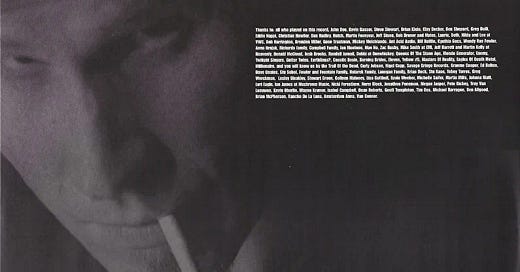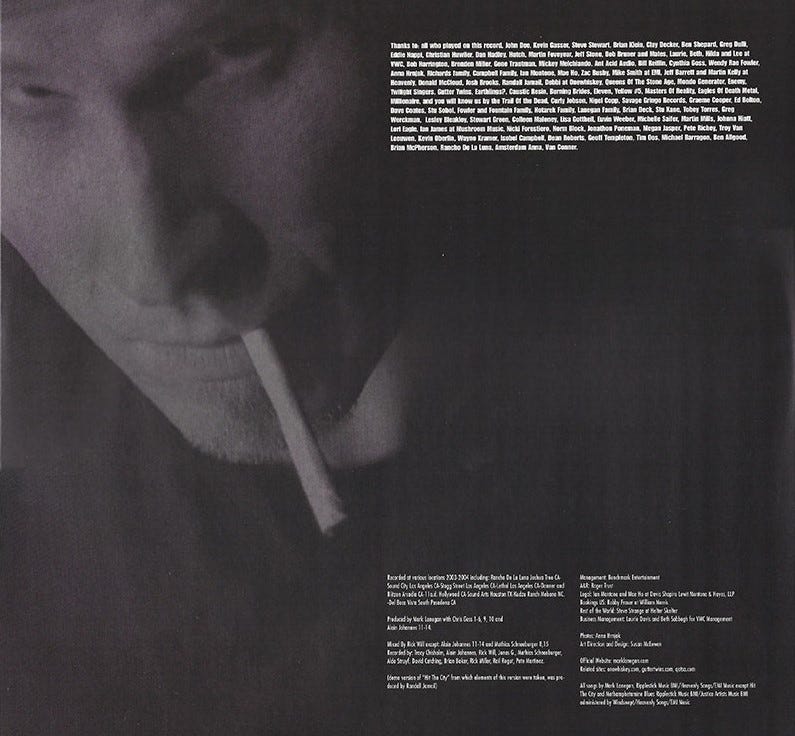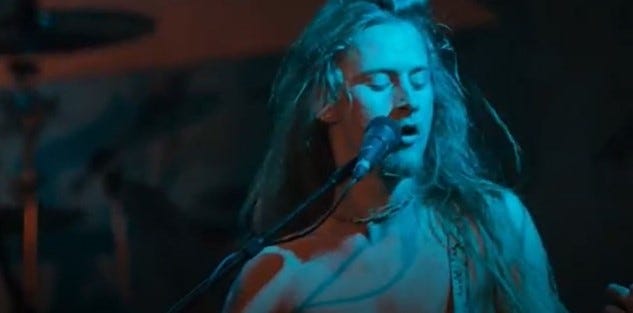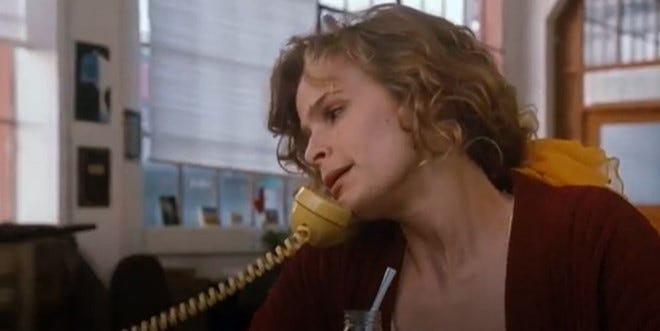Singles (1992): Seattle and Generation X Pt. I
Everything that can be invented has been invented- Holland Duell
In II parts, there will be insights, analysis and themes of Singles (1992); before continuing with the discussion of grunge design and politics furthermore. Hopefully, allowing you to see more depth, complexity and purpose behind the visuals, themes and context of the movie. And if the movie was a simple rom-com cash-in, or held a deeper purpose…
Which we will leave for each reader to decide.
Singles (1992), directed by Cameron Defeaturing is a rom-com about twenty year olds trying to find love, success, and discover what success/happiness is for them. Featuring actors such as Bridget Fonda, Matt Dillon, Campbell Scott and Kyra Sedgwick. With a soundtrack featuring legendary The ‘Mats vocalist Paul Westerberg; the one and only… Chris Cornell, Pearl Jam, Alice In Chains, Mudhoney and others.
When discussing film and grunge in a topic-Singles (1992) has been recognised as a definition of what grunge film is. The movie itself was a sign of: ‘’how far into the mainstream the movement had gone’’(Stapleton, 1995). As the Hollywood film company Warner had distributed such release, capitalising on the grunge phenomenon. Whilst, Seattle musicians such as Chris Cornell (Soundgarden) appear on one of the scenes, musicians such as Mark Lanegan (Screaming Trees) had criticised the film, as a: ‘’lame and sap-filled farce of a movie’’ (Lanegan, 2020), comparing it to General Hospital or even the: ‘’Spice Girls film’’ (Lanegan, 2020). Which he labelled as: ‘’obtuse bandwagon jump if ever there was one’’(Lanegan, 2020). If you didn’t know… Matt Dillon (who plays Cliff Poncier) received a burning cigarette into his blazer at a NYC bar from Lanegan. Once again, I will remind you to read Mark Lanegan’s biographies…
they are soo kool!
When considering the brisk criticism of the movie from musicians such as Lanegan, it becomes definite that Singles (1992) does not correctly reflect the Seattle scene. Cameron Crowe had created a mainstream format film which does not fully reflect the ideology of the 90s movement, undermining how politicised artistic works and generation X had become. Even though, the film was created before Nirvana’s Nevermind (1991) become a sensation, the distribution by Warner and the film’s heavy reliance on the soundtrack (in order to attach Grunge connotations), indicates its attempt to capitalise on the Seattle movement at the first instance available from the marketing perspective. Indicative with the enforced stereotypes and visuals, such film turns the reality of the financially despaired town into a marketable area. Undermining the underground rage vocalised by the Seattle underground or even the 80s hardcore punk scene which influenced grunge.
The use of colours is the most prominent example of how Singles (1992) captures the Seattle movement’s political ideology. Not only, by following the grunge colour scheme which is prominent in Art Chantry`s work [as discussed in previous posts & future posts], but by implementing it in the character visual presentation. Observed through character Linda wearing an orange tone attire which similar to her warm tone hair, (figure 1). Suggesting a: ‘’warm and welcoming congeniality’’ (Bellantoni, 2013), which makes the spectator interpret Linda in a way- motherly, carrying, sensible and honest. Establishing and foreshadowing from the start of the narrative her great compatibility with Steve. Important aspect to note if the Seattle movement is compared to the 80s hardcore punks and interpreted as a punk movement. As the spectator can identify the display of punk band vinyl’s such as The Replacements Let It Be (1984) and Jonny Thunders and The Heartbreakers L.A.M.F (1977) , which not only reflect the Seattle musicians’ influences correctly but shape a punk identity towards the characters and the scene itself. Attaching democratic values the punk bands carry, in order for the audience to understand the emotional profile and personality of the characters.
Notably, Black Flag or Reagan’s Youth are politically radical and often perceived as violent due to their politically anti-republican values. Therefore, Cameron Crowe is able to shift such associations away from the grunge scene by introducing warm tones in return positioning the movement in a welcoming manner. The orange tones are associated as earth colours, generating familiarity, trust, and relatability for the spectators, as they are attracted to the familiar. Such colours promote serenity and sustainability, reflecting the movement’s interest in environmental preservation from this perspective.
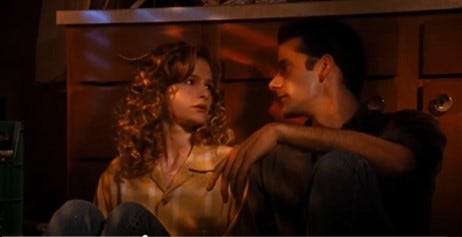
Orange significantly, is a ‘’colour that celebrates the working class’’ (Bellantoni, 2013), partly by orange being associated with the orange working uniform. Significantly, the movement had celebrated the working class by wearing thrifted clothing, changing negative associations with thrifting to positive ones, as in the contemporary, it is still fashionable to do so. Arguably, still the aftermath from grunge. The film denotes characters wearing such clothing, when considering the worn-out effect, they have and the lack of luxury they connote. In such case, the film portrays the industrial element of Seattle. Prior to the Grunge revelation, Seattle was an industrial city saturated with low income and blue-collar jobs. The city was known for it’s industrial extraction industry from wood, fishing, harvesting which all heavily declined in the 70s. More detrimental was the fall of Seattle’s Boeing company as the company produced: ‘’thousands of fighters and bombers during World War II’’ (Hinshaw, 2017). With Boing slashing: ‘’ nearly fifteen thousand jobs from 1970-1071 after cancellation of their supersonic transport program’’ (Reiff, 2020). Which put the area into a recession for nearly five years. The unemployment: ‘’surged to 12 percent, and many people departed the area to peruse opportunities elsewhere’’ (Reiff, 2020). In 1971, two real estate agents left a cynical poster declaring: “Will the last person leaving Seattle — turn out the lights” (Bussing-Burks, 2009), [Which was discussed in previous posts]. Resulting in the 80s and Generation X to grow up in financial challenging times, which were only overcome with the birth of famous tech-companies in the 90s with RealPlayer, T9, Amazon, Homegrocers.com. Indicating how deserted Seattle had become, which artists in Seattle have noted in their work, more significantly, through the themes of solitary, pessimism and nihilism. The scene had celebrated the working-class aesthetic through thrifted clothing and colour schemes discussed earlier, as such movement had represented the lower/middle class of America, which had faced economic struggles into the Ronald Reagan presidential terms. Not only strengthening the lower/middle class background of the characters, but bringing the sense of naturalism, sense of ordinary and relatability for the spectator. However, such is contrasted with the blue tone that is constantly present throughout the movie. Prominently, in the scene where Linda and Steve are talking outside of his apartment or in the performances of Alice in Chains.

Seve also wears dark blue clothing and has dark hair contrasting Linda, who constantly wears orange or yellow tone clothing as seen in exemplified images below. Whilst blue is a colour of intellect, which Pati Bellantoni describes as a colour ’’to think to, but not to act’’ (Bellantoni, 2013). Foreshadows the narrative and character of Steve who is constantly thinking about Linda, instead of expressing his feelings. The blue colour creates de-attachment, which can be seen throughout the blue solid background during start of credit sequence, de-attaching the cast from the movie. But also, through the blue mise-en-scène such as Linda’s car, symbolising Linda’s de-attachment and lack of presence in the moment which leads to an incident.
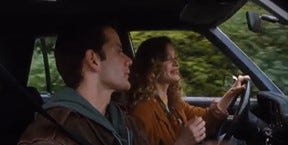
The blue/teal and orange colour scheme is widely used in film and Hollywood productions to draw contrast and bring attention to the character's face. Guiding the spectator to interpret the expressions and emotions. The inverse colours can similarly enhance the differences between the characters, as Gill Philip`s explains that: ‘’blue and orange are opposites, or complimentary, meaning that they stand at opposite ends on the colour spectrum. It is impossible for them to merge into one another’’(Philip, 2011). Something that can be metaphorised into Linda and Steve. Such can be interpreted in Linda expecting to receive Steve’s call, but he wants to come across as ‘cool’ and does not do so. But it’s worth mentioning that in the ‘’blue environment, people become passive and introspective’’ (Bellantoni, 2013). And such is seen throughout the film, during the opening scene when the spectator is introduced to Steve, reflecting on his life position, and wearing a blue shirt. He becomes passive through his acceptance of not being able to have a successful personal life and declaring full dedication to his career as he has control over it, and not relationships. Emphasised by Steve describing when his father left, he was told by him to: ‘’have fun, stay single’’, (Singles, 1992). Further, encouraging the 80s mentality of self-indulgence and lack of believe for family. Which as the movie advances, he rebels against. Suggesting, the generation X rebelling-taking the complete opposite advice of their parental generation. As the advice he followed from his parents-male figure, made him unhappy. Ultimately , leading to the the topic of 1990s emasculation seen in the cult-film Fight Club (1999), which carried themes of Luddite Utopianism, nostalgia, capitalism, masculinity… all seen within grunge & its aftermath.
Full dedication to his own career and nothing else, suggests the fear of losing control and protective mechanisms, to escape emotional harm which responsibility might give. But once again, he ends up thinking about Linda constantly, representing the fighting denial Steve proposed, between the modern and traditional values. As supported in the café scene, when he listens to advice from Janet, Bailey and Debbie. The macho-image is encouraged with Bailey`s and Debbie’s agreement that Steve shouldn’t call Linda, as: ''She’s beautiful. Anyone would call her. You distinguish yourself by not calling her'' (Singles,1992), [How stupid…sorry!]. Which later, only proves to be the cause of the misunderstanding in the relationship, disabling it’s progress. Notably, Debbie is a representation of the 80s society, when considering her appearance consisting of the characteristic 80s oversized shoulder pads, bright red, skirt suit and 80s style hairdo. Furthermore, Debbie states that Linda: ''wants mystery, who wants drama, she wants excitement, I know women''(Singles, 1992). Resulting it to be the complete opposite of the reality, as the next scene features Linda denying such characteristics. Inferring the failure of such decade, as Debbie- a women herself claiming to know what women want, in reality has no knowledge. Ronald Reagan had encouraged the display of wealth and Linda is a representation of this mentality. In particularly, when considering the rules of romance and dating with women being taught to be lady-like and feminine, as seen through the relationship examples in movies such as Dirty Dancing (1987) and Footloose (1984). Signifying that: ''generation X were annoyed by the ideology of the flashy and shallow 1980s''(Strähle, 2017). Which as a response in Singles (1992), is challenged by female characters such as Janet, who wears androgynous clothing (jeans and a plaid shirt). Reflective of musicians such as Kurt Cobain, Courtney love or Mark Lanegan. Even though, Kurt Cobain didn’t reform to the stereotypical grunge image himself, the: ‘’tattered sweaters, flannels, and distressed jeans he wore have been replicated through the ''anti-aesthetic'' of Grunge couture-which Cobain has been granted on necessity, an initial lack of money, and a minimalist wardrobe that was repeated so often it was referred to as ‘’Kurt Cobain Uniform’’(Clapp, 2016). Which later on was adapted by the scandalous fashion collection from Marc Jacobs Grunge Perry Ellis Collection (1993) which cost his job but was re-issued in 2018 as Grunge Redux. The grunge attire throughout the male and female characters in the movie, allows to create a sense of equality, as spectators are not drawing stereotypes or traditionalist mentality expectations of what women should be. The visuals alone, do not create power dominance or authority over the male or female characters. As both genders wear jeans-quite universal and androgynous clothing, if compared to Debbie who illustrates her fascination with Hollywood bombshell Brigitte Bardot for her music video idea. Setting a clear separation of the decades and generation X interpretation of a women.
’’Bands like Nirvana and The Smashing Pumpkins popularized the blue-collar chic uniforms of flannel lumberjack shirts teamed with Dr.Martens. The post-feminism subculture of the Riot Grrrls wore the Dr.Marten boots with frilly dresses and fuelled its popularity among American women’’(Lynch and Strauss, 2015). Only to revolve to the idea of recycle culture, and cyclical behaviour of trends and grunge’s relevance in mainstream culture in the past years.
But grunge itself wasn’t the punk anti-fashion declaration, it was un-fashion and was: ‘’about not making a statement, which is why it’s crazy for it to become a fashion statement'' (Strähle, 2017).
Following an attainable lower and middle class-thrift store attire. Which was popular from the store The New Store in Seattle, with memorable figures such as Pony and Stormy, bringing a huge inspiration on the vintage-Seattle style. Only to show it’s aesthetical values influence and power over the practicality of second hand clothing. Which again, attaches the idea of grunge being an interpretation of the past, rather something completely new. Leading back to Luddism & nostalgia discussed in previous posts. With the idea of Charles Holland Duell that: ‘’everything that can be invented has been invented’’(Bishop, 2000). Promoting the ide of cycles, which from a political view suggests Arthur M. Schlesinger and Arthur M. Schlesinger Jr. Cyclical Theory of the: ‘‘swing between conservatism and liberalism, between periods of concern for the rights of the few and periods of concern for the wrongs of the many’’ (Schlesinger, 1999).
The motif of dedicating one’s life exclusively to a profession is discussed not only through the example of Steve but Cliff Poncier. Most notably, Cliff Poncier`s progression as a character is the most prominent, regarding the issue of hyper-masculinity and the rock star persona, highly reflective of 90`s neglect of such ideas. For the fact that, Cliff explains that: ‘’not everybody needs to be with someone… not me, my music is all the juice I’ll need’’ (Singles, 1992). Similarly, as Cliff dedicates his life to his music ambitions, resulting in both male characters to appear as work-driven, following the stereotypes of ‘tough men’ and hypermasculinity. Such stereotypes assimilate romantic relationships with emotions, which hypermasculinity connotes with weakness. As both with such declarations indicate that in order to be successful in a career one can’t focus on relationships, suggesting, that men are not concerned with romantic relationships or romance. An element that would be representative more of the 50s gender roles in the American society. Partly, reflecting the masculinity crisis of the 90s. Judith Butler defines identity as socially constructed: ‘’an identity tenuously constituted in time-instituted through a stylised repetition of acts’’ (Butler, 1988). Meaning, that the characters focus on work aspects, denotes the characteristics of stereotypical idolisation of men.
Whilst Cliff does not appear visually as a hyper-masculine character, he is displaying such idea as he suggests that men are not concerned with relationships. In contrast, he is obsessed with his music, when considering it as his job, such is reflective of the 80s Reaganomics, which desired one to display their wealth. If such can be interpreted as arrogance, it is further inferred through the Citizen Dick band member scene. Altogether, reading the reviews in a newspaper of the band, Cliff confidently smirks and winks as he remarks:
’’I don’t want to hear anything negative’’ (Singles, 1992). Showcasing confidence, denial, and the lack of ability to face criticism or the truth, in order to preserve his ego. He is assured of the positive praise he will receive without hearing it, suggesting, that music is not his primary goal, but appraisal and success is. Cliff does not display high intelligence or empathy for other characters and his music appears primitive. With primitive lyrics, especially through the Mudhoney’s song ‘’Touch Me I’m Sick’’ (1988), which in the film is turned into ‘’Touch Me I’m Dick’’ (1992). Working as a metaphor for the rock`n`roll ethics and figures in the previous generation of rock musicians. Cliff loses concentration when he writes songs for Janet, wondering off from the meaning of the lyrics into technical failures of his playing. Suggesting, a troubled character, which is constantly seeking appraisal and in reality, is not the confident persona he is displaying. In contrast appearing insecure, with this Cameron Crowe reflects the masculinity crisis, suggesting, that men are expected to be career driven, therefore, appearing masculine. Such is reflective of the mythopoetic men`s movement in the 80s and 90s, which: ‘’took from Jungian psychoanalyses the notion of essential archetypes conditioning masculine and feminine nature, and combined these with myths from variety of cultures to produce philosophy of American male identity and its contemporary ills… men who had become soft and unassertive in the face of feminist challenges and the lack of male role models could readdress the wounds of masculinity and reconnect with a deep masculine essence’’ (Caroll, 2003). Whilst, such movement aimed to liberate men, it is furthermore, enhancing the primitive stereotype and connotations between masculinity, and wilderness, as the mythopoetic men`s movement created retreats in the wilderness and used Native American rituals such as drumming or chanting. All gaining momentum as: ‘’more women won political office than ever before in 1992, the so-called Year of the Woman’’(Yarrow, 2018) and the first woman Attorney General Janet Reno and first female United Stas Secretary of State- Madeleine Korbel Albright. Singles (1992), contrasting to such movement’s beliefs appear more aligned with the feminist ideology, when considering that Linda leaves Steve and dedicated herself for work after their miscarriage. Reflective of the ideology of Cliff and Steve initially, as in the development of the climax of the film, both male characters become concerned with their romantic relationships. When identifying the end of the narrative, the messages let the spectator understand that both of the characters happiness was not in their work-but in romantic relationships. [How sweet :)]
The fact that Steve debates between listening to Janet or Jim-True Frost, signifies, gender equality and possibly even power role change as there are more women giving him advice then men in the film. Symbolizing, the nation of single mother households. And particularly Steve who mentions: ‘’my dad left home when I was eight’’(Singles, 1992). Highlighting that the 90s is labelled as a: "generation of men raised by women" (Out Issues 74–81, 2000), especially, which was evident from the movie Fight Club (1999) with the character of Tyler Durden and the Narrator. Therefore, challenging the ideas regarding hypermasculinity. Whilst Steve and Linda were apart, Steve becomes jobless and becomes introverted in his apartment. Such situation brings connotations of the 50s family model. In which the wife is expected to stay at home, whilst the husband reaches a successful career path. However, Linda and Steve have reversed such gender roles, resulting in a film which is filled with female empowerment, but also empowers men to break gender stereotypes against the 80s hypermasculinity identified through figures such as Sylvester Stallone and Arnold Schwarzenegger in the Western society. With notable films such as Robo Cop (1987), Terminator Franchise, which further drives the hypermasculinity, as the robotic, un-human figures become more powerful and colder than the hyper masculine men.
When considering the fact that the rest of the band (all Pearl Jam members in the film are in Cliff’s band: Citizen Dick) and they contrast in their behaviour to Cliff, appearing anything but arrogant, suggests, that the Seattle movement is against such ideas. The regular persona of the Pearl Jam members makes the musicians appear likeable and more relatable to not only established musical fans but potential new spectators. Such characterisations are only strengthened with the scene featuring Chris Cornell, as he is stood quietly next to Cliff with no recognition desired. Therefore, if Cliff is a symbol of the 80s mentality, Cameron Crowe presents such ideas with amusement, placing such ideas in an unfashionable and undesirable manner. It grants an insight on the rockstar stereotypes of the 80s, as films like The Decline Of Western Civilization Part II (1988), showcase, that rock`n`roll is about ‘’metal, guitars, girls’’ and ‘’to be a rock`n`roll star is the greatest thing in the world’’ (The Decline Of Western Civilization Part II: The Metal Years Official Trailer # 1 [1988], 2015).
Something that Cliff appears to agree on, yet the film showcases such mentalities failure when he does not result in a successful career. Drawing antipathy and empathy from the spectator towards the character. Jonathan Cohen has suggested that: ‘’given that empathy is a central component of identification with characters, greater identification is likely to lead to greater enjoyment of the messages’’ (Igartua, 2010). However, Singles (1992) crafts Cliff in a manner which revokes antipathy, which in result grants enjoyment for the audience. Audiences can identify against Cliff’s character, bringing enjoyment, due to the emotional response experienced. Especially, when considering Seattle’s mainstream popularity, meaning that its feminist and anti-hypermasculine ideas would be subscribed by the mainstream audiences who had popularised the movement. Norbert Wiley explains that the: ‘’intense negative emotion in the main world can be traumatic or at least highly unpleasant. In the movie world, this is almost never so (though Psycho and the Exorcist were major exceptions). Similarly, happy emotions in movies are pretty invulnerable to betrayal and heartbreak. Once you have them, you pretty much have them’’ (Igartua, 2010). In Singles (1992), heartbreak and love are central themes which lead to important character development.
Partly when observing the power dynamic and progression of Cliff`s and Janet`s relationship, the conclusion of the film indicates the coming-of-age characteristics for both characters. Especially, when both characters break up, Cliff finds Janet in a café only to plead: ‘’I miss you, the way you used to look at me''(Singles, 1992). Indicating that Cliff`s primary goal is not music like he explained before, breaking the rock star façade and hypermasculine behaviour he had displayed previously. Showcasing vulnerability, Cliff with arrogance highlights, that he misses the way she looked at him, however the power roles have been shifted when Janet simply explains that: ''I mean, you know still really like you, you know, I think you’re really entertaining''(Singles, 1992). Shocking Cliff, as his stunned facial expression reveals. Janet mirroring Cliffs previous behaviour becomes unbelievable to him. It is an episode which positions the male and female character in the equal position, and in the particular situation makes the female character more powerful. Furthermore, Janet introspects: ‘’What am I doing? I don’t have to be here, I could just break up with him, I’ve always been able to do this, break up with someone and never look back… being alone, there’s a certain dignity to it’’(Singles, 1992). Suggesting, female empowerment, independence, and liberation, which in the opening sequence of the film, Janet did not exude.
In such manner, Janet’s character ‘comes-of-age’ when considering that she becomes independent from Cliff. Reflecting, the fact that though girl images arose in 80s and: ‘’mid-90s many stronger girls appeared, becoming more enterprising and dynamic’’ (Shary, 2014). Breaking the stereotype of the vulnerable female character into a confident and quite ‘macho’ image herself, switching gender roles within the film. Similarly, Cliff at the beginning of the film is quite careless towards Janet and was not merely interested in what she wanted or how he made her feel. Carelessly encouraging her to improve her looks with cosmetic surgery, he further generates antipathy as he is inconsiderate of Janet. But as Janet breaks the relationship apart, he is seen learning from his experience as he denotes romantic gestures such as writing songs and drawing Janet’s name with rose pedals. Something that would not be associated with hypermasculinity. Suggesting, that the egoistic, distant persona must be broken in order to find his happiness.
Kevin L. Furgeson, described that Singles (1992) doesn’t give insight: ‘’ultimately how neither the professional nor the poetic lifestyle has any particular insight into what love is in the 1990s’’(Ferguson, 2019). Which possibly is caused by the many juxtapositions in the plot, as an example, when Linda says: ''This guy plays no games'' (Singles, 1992), the next shot is of Steve mentioning: ''I gotta play this one perfectly'' (Singles, 1992). With the constant references and even slight indecisiveness of the correct dating models from the past generation and the modern one. However, it does emphasise the previous generation’s ideologies to be not effective in the 90s. Which implies the decade to be about not being afraid to be yourself, especially when considering male expectations, with emasculation crisis in the 90s and women taking on the workforce more rapidly. Which allowed more discussion and acceptance to men to be more vulnerable and emotional, ultimately similar to women and be ‘human’. Especially, this is seen across films such as Fight Club (1999), who are semi-considered as a grunge format, especially, throughout the graphic design and visuals. Featuring also female characters such as Marla, who embrace the Riot Grrrl aesthetic, mirroring Courtney Love’s proposed behaviour and fashion.
When considering the films position in the Grunge associations, such character development is reflective of the feminist 90s Riot Grrrrl movement which was present in Seattle. Most notably, Courtney Love from Hole is an important figure as she had inspired grunge fashion and feminism in rock`n`roll, becoming an icon of the 90s. However, still she had faced criticism for her behaviour which majorly came from conservatists. Whilst the film does not showcase feminism to the same level as the rock musicians had displayed, it is following the commercialisation of the movement, which helped to transition the scene into a mainstream format. It is more accessible to spectators as it is significantly less radical than the musicians themselves, when considering the fact that Kurt Cobain, Mark Lanegan or Billy Corgan wore dresses and make-up on performances, or the controversial incident were the female band L7 threw a tampon at the audience exclaiming: "Eat my used tampon, fuckers!" (Ojos de mosca, 2020). Furthermore, it focuses on the universal truth element, regarding romantic relationship issues, neglecting how politicised the movement had become. No longer you were exclusively grunge if you: ‘’lived in Seattle and were under 30 at that point’’ (Yarm, 2011). The audience becomes a part of the narrative-ultimately the movement itself without the need to change the spectators’ characteristics or values. Which when it comes to the punk identity is a challenging and conflicting aspect, as hardcore punk bands along the East Coast cemented and demanded political uniformity and action across the scene and their listeners. Therefore, the film is more welcoming of diverse spectators as their political values are not questioned.
However, it is important to note that the film suggests that one needs to find themselves, their own individuality in order to create a healthy union. As seen by the character of Janet, she tries to find her worth, confidence and personality trough Cliff. As if, he is everything to her and what she talks about-what she introduced herself as. Her lack of confidence caused by Cliff’s ideal images of women and non-commitment, drives her to change herself visually with considering plastic surgery. As she meets a doctor in the appointment, she meets a man who infers he will accept as she is and treat her as she deserves. She is oblivious of the fact the man she described is in front of her, as she still dreams about Cliff. Her unhealthy obsession, delusions and imaginations of Cliff take over her life. And only when she breaks up with him, she has her confidence and finally persues into collage. Which showcases once again, that her relationship problems caused lack of development and stopped her from her dreams in her professional career. And not recognising the possible relationship opportunities as seen by her visit at the surgeon. The character shows the lack of confidence which the society faced, with insecurities. In this case, in particularly with women with rise of 90s supermodel culture, heroin chic and with the rise of 24-hour news which lead to sexism and constant harassment as these news stories once featured, were kept for weeks and months. If women gained power and were in public, the society: ’’pushed back by reducing them to gruesome sexual fantasies and misogynistic stereotypes. Women’s careers, clothes, bodies, and families were skewered’’ (Yarrow, 2018). Which turned sexual victimisation into a fault of the victim themselves. And similarly, Janet transfers Cliff’s lack of emotional affection as her own fault due to her physical appearance. In naïve way, suggesting the only way to attract a man is through physical appearance.
To be continued…but for now, check this:
Origins of Grunge Design Pt. II : Art Chantry, David Carson and depoliticized sensibility?
Before we get into discussing Art Chantry, it is worth discussing David Carson. From Chantry’s own words, he became the ‘’most famous graphic designer in the world’’ (Chantry, 2015.p.121), turning into a ‘’rock star designer’’(Chantry, 2015,p.121) in the 90s. He deliberately has been said to break rules of design such as to ‘’never mix typefaces on a sin…


